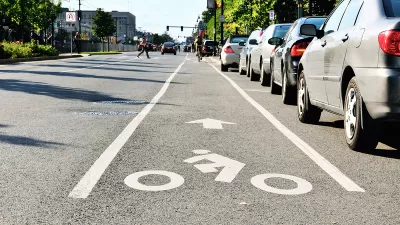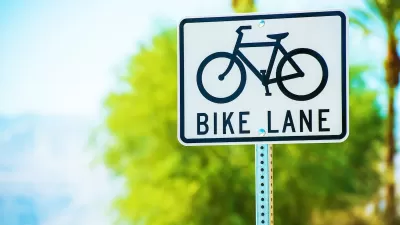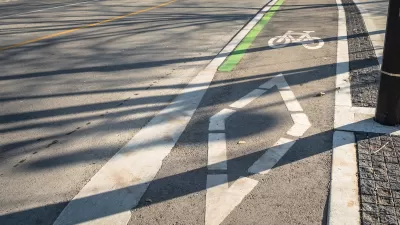A case is made in the Orange County, California, city of Garden Grove for protected bike lanes. And a new protected bike lane opens in Southern California's bike infrastructure capital, Long Beach.

Good news for walkers and cyclists in Orange County, California. After years of seeing bike and pedestrian funding left unused, the Orange County Transportation Authority "awarded about $19.5 million to six Orange County cities and the county for bicycle and pedestrian mobility projects," reports Erika Aguilar for KPCC, Southern California Public Radio. "It had double the number of project pitches and funding requests." [Listen here.]
The money comes from the federal Congestion Mitigation and Air Quality Improvement program, [aka CMAQ] which provides funding for projects that meet the Clean Air Act requirements.
Garden Grove, fifth largest of the 34 cities in the county, "received $1.1 million from OCTA to make improvements," notes Aguilar. But is designating bike lines with white stripes and bike icons on the right shoulder of existing roadways enough?
Data shows that "the city's existing bike lanes are under-utilized," reports Aguilar.
The city counted bicyclists last September and in the report, released in June, found the majority rode on the sidewalk. A full 40 percent chose to ride on the sidewalk even when bike lanes were present.
Byron Von Korper, owner of Papa Wheelie Bicycles in Garden Grove, said the city "needs to take a page from the city of Long Beach where some bike lanes are separated from vehicle traffic, have physical barriers from the street, and their own traffic signals," adds Aguilar.
The comparison to the second most populous city in Los Angeles County is a good one. According to an April 2011 Streetsblog LA article by Joe Linton, "Long Beach is Southern California’s undisputed leader in innovative infrastructure for safe and convenient bicycling." That month the city "unveil(ed) the first genuine protected bike lane [running on Third Street and Broadway] west of New York City."
On Thursday, the city celebrated the opening of the Artesia protected bike lane, reports Linton.

Long Beach Mayor Robert Garcia (center) and Vice Mayor Rex Richardson (left, white shirt) tour the new Artesia Blvd protected bike lanes. Photos: Joe Linton/Streetsblog L.A. [Permission given.].
The lanes are parking-protected, and feature green plastic reflective bollards, rubber curbs, and intermittent green pavement markings.
Note the photo with temporary signage directing where motorists should park and where cyclists should ride in the parking-protected bike lanes.
Notably absent are bicycle traffic signals. Linton explains:
At approaches to intersections and at bus stops, the protection drops and there is a merge zone marked with dashed green pavement. (Not dropping the protection would require relatively expensive bikeway signals, similar to Long Beach’s Broadway/Third couplet.)
The event highlighted Long Beach Bike Share which began operation on March 19, 2015.
Finally, the transition in bike planning in Orange County, going from undersubscribed to oversubscribed, reflects what was the topic of a "post peak car" discussion (posted Saturday) among transportation experts on the future of planning in urban centers.
"The push for more bike infrastructure comes with Orange County's transition from a bedroom community to a dense urban environment," notes Aguilar.
OCTA awarded Santa Ana, the county seat and second most populous city after Anaheim, "$4.4 million in funding for three projects that will add protected or buffered bike lanes," adds Aguilar.
Hat tip to AASHTO Daily Transportation Update.
FULL STORY: Bike lane projects become popular in Orange County

Alabama: Trump Terminates Settlements for Black Communities Harmed By Raw Sewage
Trump deemed the landmark civil rights agreement “illegal DEI and environmental justice policy.”

Planetizen Federal Action Tracker
A weekly monitor of how Trump’s orders and actions are impacting planners and planning in America.

The 120 Year Old Tiny Home Villages That Sheltered San Francisco’s Earthquake Refugees
More than a century ago, San Francisco mobilized to house thousands of residents displaced by the 1906 earthquake. Could their strategy offer a model for the present?

In Both Crashes and Crime, Public Transportation is Far Safer than Driving
Contrary to popular assumptions, public transportation has far lower crash and crime rates than automobile travel. For safer communities, improve and encourage transit travel.

Report: Zoning Reforms Should Complement Nashville’s Ambitious Transit Plan
Without reform, restrictive zoning codes will limit the impact of the city’s planned transit expansion and could exclude some of the residents who depend on transit the most.

Judge Orders Release of Frozen IRA, IIJA Funding
The decision is a victory for environmental groups who charged that freezing funds for critical infrastructure and disaster response programs caused “real and irreparable harm” to communities.
Urban Design for Planners 1: Software Tools
This six-course series explores essential urban design concepts using open source software and equips planners with the tools they need to participate fully in the urban design process.
Planning for Universal Design
Learn the tools for implementing Universal Design in planning regulations.
Clanton & Associates, Inc.
Jessamine County Fiscal Court
Institute for Housing and Urban Development Studies (IHS)
City of Grandview
Harvard GSD Executive Education
Toledo-Lucas County Plan Commissions
Salt Lake City
NYU Wagner Graduate School of Public Service




























